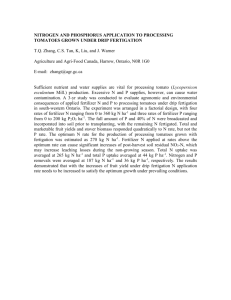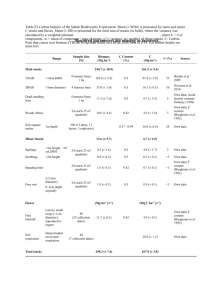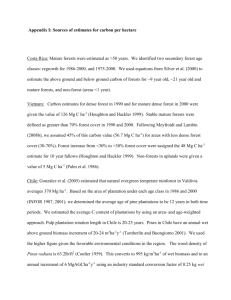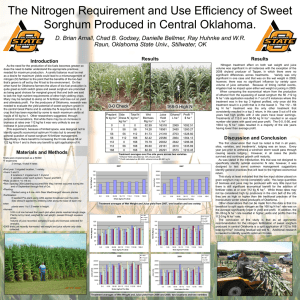Document 14258405
advertisement
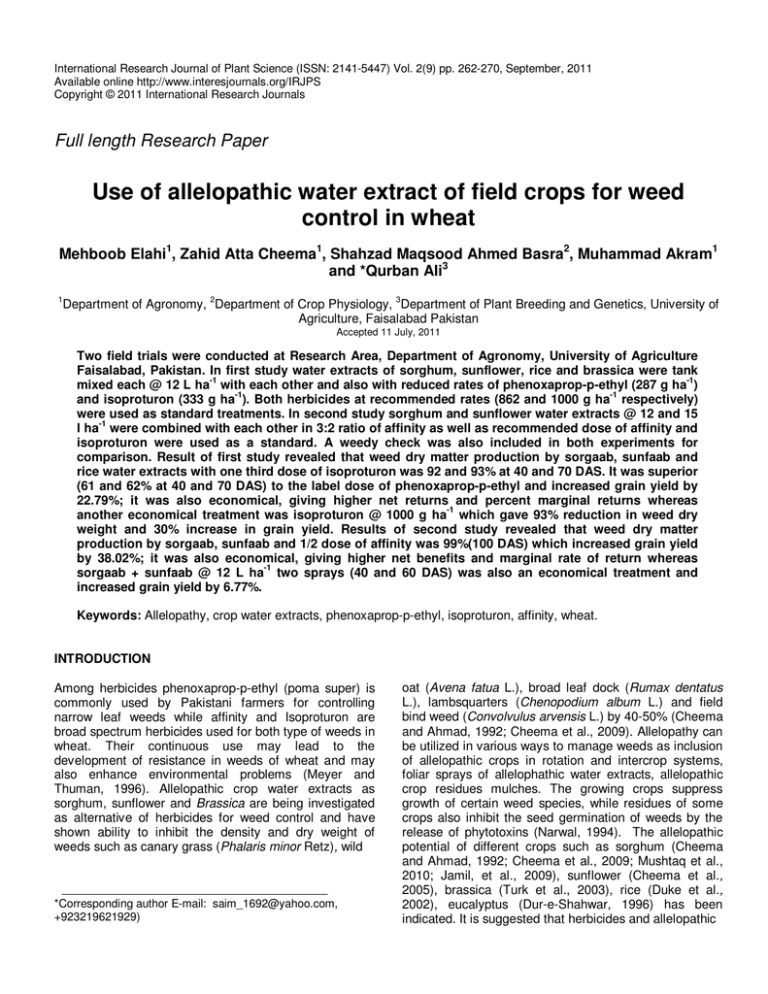
International Research Journal of Plant Science (ISSN: 2141-5447) Vol. 2(9) pp. 262-270, September, 2011 Available online http://www.interesjournals.org/IRJPS Copyright © 2011 International Research Journals Full length Research Paper Use of allelopathic water extract of field crops for weed control in wheat Mehboob Elahi1, Zahid Atta Cheema1, Shahzad Maqsood Ahmed Basra2, Muhammad Akram1 and *Qurban Ali3 1 Department of Agronomy, 2Department of Crop Physiology, 3Department of Plant Breeding and Genetics, University of Agriculture, Faisalabad Pakistan Accepted 11 July, 2011 Two field trials were conducted at Research Area, Department of Agronomy, University of Agriculture Faisalabad, Pakistan. In first study water extracts of sorghum, sunflower, rice and brassica were tank mixed each @ 12 L ha-1 with each other and also with reduced rates of phenoxaprop-p-ethyl (287 g ha-1) and isoproturon (333 g ha-1). Both herbicides at recommended rates (862 and 1000 g ha-1 respectively) were used as standard treatments. In second study sorghum and sunflower water extracts @ 12 and 15 l ha-1 were combined with each other in 3:2 ratio of affinity as well as recommended dose of affinity and isoproturon were used as a standard. A weedy check was also included in both experiments for comparison. Result of first study revealed that weed dry matter production by sorgaab, sunfaab and rice water extracts with one third dose of isoproturon was 92 and 93% at 40 and 70 DAS. It was superior (61 and 62% at 40 and 70 DAS) to the label dose of phenoxaprop-p-ethyl and increased grain yield by 22.79%; it was also economical, giving higher net returns and percent marginal returns whereas another economical treatment was isoproturon @ 1000 g ha-1 which gave 93% reduction in weed dry weight and 30% increase in grain yield. Results of second study revealed that weed dry matter production by sorgaab, sunfaab and 1/2 dose of affinity was 99%(100 DAS) which increased grain yield by 38.02%; it was also economical, giving higher net benefits and marginal rate of return whereas sorgaab + sunfaab @ 12 L ha-1 two sprays (40 and 60 DAS) was also an economical treatment and increased grain yield by 6.77%. Keywords: Allelopathy, crop water extracts, phenoxaprop-p-ethyl, isoproturon, affinity, wheat. INTRODUCTION Among herbicides phenoxaprop-p-ethyl (poma super) is commonly used by Pakistani farmers for controlling narrow leaf weeds while affinity and Isoproturon are broad spectrum herbicides used for both type of weeds in wheat. Their continuous use may lead to the development of resistance in weeds of wheat and may also enhance environmental problems (Meyer and Thuman, 1996). Allelopathic crop water extracts as sorghum, sunflower and Brassica are being investigated as alternative of herbicides for weed control and have shown ability to inhibit the density and dry weight of weeds such as canary grass (Phalaris minor Retz), wild *Corresponding author E-mail: saim_1692@yahoo.com, +923219621929) oat (Avena fatua L.), broad leaf dock (Rumax dentatus L.), lambsquarters (Chenopodium album L.) and field bind weed (Convolvulus arvensis L.) by 40-50% (Cheema and Ahmad, 1992; Cheema et al., 2009). Allelopathy can be utilized in various ways to manage weeds as inclusion of allelopathic crops in rotation and intercrop systems, foliar sprays of allelophathic water extracts, allelopathic crop residues mulches. The growing crops suppress growth of certain weed species, while residues of some crops also inhibit the seed germination of weeds by the release of phytotoxins (Narwal, 1994). The allelopathic potential of different crops such as sorghum (Cheema and Ahmad, 1992; Cheema et al., 2009; Mushtaq et al., 2010; Jamil, et al., 2009), sunflower (Cheema et al., 2005), brassica (Turk et al., 2003), rice (Duke et al., 2002), eucalyptus (Dur-e-Shahwar, 1996) has been indicated. It is suggested that herbicides and allelopathic Elahi et al. 263 products may work complementarily and the herbicidal dose may be reduced when applied in combination with allelopathic products (Cheema et al., 2002). In a relevant study sorgaab controlled weeds up to 35-49% and increased wheat yield by 10-20%. Mature sorghum, chopped herbage (2-6 Mg ha-1) incorporated in the soil at sowing, controlled weeds up to 40-50% and increased wheat yield by 15% (Cheema and Khaliq, 2000; Mushtaq et al., 2010). A single spray of 5% sorgaab solution applied 30 days after sowing increased wheat yield by 14% and suppressed weed biomass by 20-40% (Cheema et al., 1997). The objectives of present study were to evaluate the efficacy of different allelopathic water extracts as sorghum, sunflower, rice and brassica tank mixed with lower doses of three herbicides under semi arid conditions of Faisalabad, Punjab. MATERIALS AND METHODS Experimental details Field experiments were conducted to study the effectiveness of allelopathic properties of sorghum, sunflower, brassica and rice for weed control in wheat grown at the Agronomic Research Area, University of Agriculture, Faisalabad, Pakistan. The soil belongs to Lyallpur soil series (Aridisol-fine-silty, mixed, hyperthermic Ustalfic, Haplargid in USDA classification scheme). The pH of saturated soil paste and electrical conductivity (EC) were 7.9 and 0.41 dS m-1, respectively. Sorghum, sunflower, brassica and rice plant herbages were harvested at maturity, dried, chaffed with fodder cutter in 2 cm pieces and kept under cover to avoid possible leaching by rain water. Chaffed material was soaked in distilled water in 1:20 ratio (Hussain and Gadoon, 1981) for 24 h at room temperature and then filtered through a screen to prepare water extracts. The 0 water extracts were either used fresh or frozen at –15 C for subsequent use. Seedbed was prepared by giving three cultivations and plankings. Wheat was sown manually on a moist seedbed by a single row hand drill in 22 cm apart. In addition to soaking, irrigation was applied at tillering, stem elongation, booting, anthesis and grain development stages. Soaking irrigation and each of the subsequent irrigation comprised 4 and 3 ha cm, respectively. Data on weed density and weed biomass were recorded on 40, 60, 70 or 90 days after sowing (DAS) from two randomly selected quadrates (m2) from each experimental plot. Weed dry weight was recorded after drying the weeds in an oven at 70 0C for 72 h. Data on wheat plant height and grains per spike were recorded from 20 randomly selected samples taken from each plot. Fertile tillers per unit area (m2) were recorded from two randomly selected sites from the experimental plot. A random sample was obtained from each plot to take 1000-grain weight. Grain yield was recorded on plot basis and converted to Mg ha-1. Data collected were analyzed statistically by using the MSTAT program (Freed and Eisensmith, 1986; Cheema et al., 2009). Experiment 1: Effect of sorghum, sunflower, brassica and rice water extracts on weeds and wheat Allelopathic effects of sorghum, brassica, sunflower and rice water extracts were studied on the growth of different rabi (winter) weeds and on the growth yield of wheat during 2004-05. The study comprised the following treatments: sorgaab + brassica + sunfaab, sorgaab + brassica + rice, sorgaab + sunfaab + rice and brassica + sunfaab + rice each @ 12 L ha-1. All the treatments were tank mixed with either 287 g ha-1 (1/3rd of the label dose) -1 rd of phenoxaprop-p-ethyl or 333 g ha (1/3 of the label -1 dose) of isoproturon and 862 g ha of phenoxaprop-pethyl as well as 1000 g ha-1 of isoproturon used as standard treatments. A weedy check was maintained as control. The experiment was laid out in randomized complete block design with four applications in plots 7m x 2.2m. Wheat (variety Uqab-2002) was sown on a well prepared land in 22cm spaced rows with single row hand drill on November 25, 2004, using 125 kg ha-1 seed. Fertilizer @ -1 -1 64 kg ha N. and 46kg ha P2O5 was used in the form of urea and diammonium phosphate, respectively. Half nitrogen and full dose of the phosphorus were applied at the time of sowing, while the remaining half was applied at first irrigation. Volume of spray (320 L ha-1) was determined by calibration. Crop water extracts such as sorghum, sunflower, brassica and rice were tank mixed in combination with each other and with reduced dose (1/3) -1 of phenoxaprop -p-ethyl @ 287 g ha or isoprotoron @ -1 333 g ha applied in the respective plots, using knapsack hand sprayer using T-jet nozzle. Experiment 2: Effect of volume and frequency of water extracts on weeds and wheat The effects of volume (12 and 15 L ha-1) and frequency of sprays of sorgaab and sunfaab on the growth of weeds and wheat during 2004-05 were compared with standard doses of chemical herbicides. The experimental procedures were same as in experiment 1. Same procedures were adopted to grow weed in the plot measuring in the same plot size. The second study comprised the following treatments: sorgaab + sunfaab either @ 12 L ha-1 or 15 L ha-1 with either 500 g ha-1 (one half of the label dose) or 333 g ha-1 (1/3rd of the label dose) of affinity and 1000 g ha-1 of both herbicides (label 264 Int. Res. J. Plant Sci. dose of affinity as well as isoproturon) used as standard. A weedy check was maintained as a control treatment. Economic analysis Total cost for all the experimental treatments was calculated after determining the prices of all inputs used in field. Costs that vary (Variable cost) are the costs (per ha) of purchased inputs, labour, and machinery that vary between experimental treatments (Byerlee, 1988). Average yield was adjusted downward (10%) to reflect difference between the experimental yield and the yield farmer could expect from the same treatment. Net benefits were calculated by subtracting the total variable cost from the gross benefits for each treatment. Dominance analysis was carried out by first listing the treatments in the order of increasing variable costs. Any treatment that had net benefits that were less than or equal to those of a treatment with lower variable cost was taken to be dominated. Finally marginal rate of return (MRR) was calculated by dividing the marginal net benefits (change in net benefits) by the marginal cost (change in cost) and expressed as a percentage. RESULTS AND DISCUSSION Experiment 1: Effect of sorghum, sunflower, Brassica and rice water extracts on weeds and wheat Weed population and weed dry matter production of both broad and narrow leaf weeds were significantly suppressed by all the treatments as compared with weedy check (Table 1). The prominent weed species observed in the experimental field were Phalaris minor Retz, Coronopus didymus (L) Smith and Melilotus Parviflora Desf. Combination of 1/3rd doses of isoproturon (333 g ha-1) with sorgaab + brasaab + sunfaab, sorgaab + brasaab + ricaab, sorgaab+ sunfaab + ricaab and brassica +sunfaab + ricaab each at 12 L ha-1 applied as foliar spray at 25DAS inhibited the population and dry matter production of broad leaf weeds by 94 to 97% and 96 to 99% respectively and it was equal to the recommended dose of isoproturon (1000 g ha-1) with 9899%. Among water extract combinations, sorgaab + sunfaab + ricaab with 1/3rd dose of isoproturon (333 g ha1 rd -1 ) and1/3 dose of phenoxaprop-p-ethyl (287 g ha ) resulted in best control of narrow leaf weed population (93, 89%) and dry matter (85, 99%) which was statistically equal to the label dose of isoproturon (91 , 82%) and better than lable dose of phenoxaprop-p-ethyl (45 , 60%). Mixing of sorgaab + brasaab + ricaab and T5 rd with either of the herbicides (1/3 dose) was relatively less effective against narrow leaf weeds; however, in case of broad leaf weeds, T5 was quite inhibitory. rd Combination of brasaab + sunfaab + ricaab with 1/3 dose of isoproturon was also very effective in controlling both the broad leaf and narrow leaf weeds. These water extracts mixed with 1/3rd dose of phenoxaprop-p-ethyl were also quite inhibitory against narrow leaf weeds. The results indicate that water extracts such as sorgaab + sunfaab + ricaab can be used to reduce the doses of the herbicides by 67% and these extract combinations enhance the effectiveness of certain herbicides. These findings support the suggestion of Cheema et al. (2003, 2009) that allelopathy may be manipulated to reduce herbicide dose. Wheat grain yield (5.4 Mg ha-1) was highest in given treatment details by isoproturon at 1000 g ha-1 (label dose) but statistically on par followed by T7 (5.08), T10 (5.01). The treatment combination T2 (sorgaab+sunfaab+brasaab) and T8 rd (brasaab+sunfaab+ricaab) with 1/3 dose of phenoxaprop-p-ethyl was least effective with only 4.56 and 4.67 Mg wheat yield (Table 2). The water extract combination of sorgaab, sunfaab and ricaab with 333 g ha-1 (1/3rd dose) of isoproturon also enhanced productive tillers and 1000-grain weight. The increase in grain yield was due to better weed control in these treatments. Weed inhibition was due to suppressive effect of water extracts and compatibility with the herbicides that possibly enhanced plant food resources availability for plant growth and more translocation of photosynthates towards reproductive parts that ultimately increased grain yield (Salisbury and Ross, 1978; Cheema et al., 2009; Jamil et al., 2009). Economic and marginal analyses show that @1000 g ha-1 (lable dose) produced highest net benefits of Rs. 47585 ha-1 with an expenditure of Rs. 898 per hectare and marginal rate of return of 795% (Tables 3 and 4). The combination of sorgaab, sunfaab and ricaab with 1/3rd dose of isoproturon was also an economical -1 treatment with fairly net benefits (Rs. 45131ha ) with an expenditure of Rs. 589 per hectare and reasonably high MMR 134% (Table 4); while all other treatments were uneconomical and dominated due to high costs that vary. Experiment 2: Effect of volume and frequency of water extracts of sorghum and sunflower on weeds and wheat The effect of different treatments on total weed dry weight was not uniform (Table 1b). The reduction in dry weight was very effective by treatment combination of sorgaab and sunfaab each @ 15 l ha-1 with 333 g ha-1 (1/3rd dose of affinity) ranging from 94-99%. This decrease in dry weight was comparable to the full doses of both herbicide (affinity, isoproturon), giving 70-100%. The treatment Elahi et al. 265 Table 1a. Effect of various allelopathic crop water extracts in combination with reduced rates of two wheat herbicides on weed density and dry weights (0.25 m2) Treatment No. Extract /Herbicide Broad leaf weeds Rate Dry weight Dry weight 4.98a (-) 3.03b (39.16) 1.49a (-) 0.08h (94.63) 6.47a (-) 3.11b (51.93) 12 L each +333 g a.i.ha-1 0.06g (98.79) 0.44f (70.47) 0.50d (92.27) 12 L each+287g a.i.ha-1 1.36d (72.69) 0.82c (44.97) 2.18bc (66.31) 12 L each +333 g a.i.ha-1 0.11fg (97.79) 1.09b (26.84) 1.20c (81.45) 12L each +287g a.i.ha-1 0.72e (85.54) 0.01 (99.33) 0.73d (88.72) 12 L each +333 g a.i.ha-1 0.18g (96.38) 0.22g (85.23) 0.40d (93.81) 12 L each +287g a.i.ha-1 1.51d (69.68) 0.12h (91.95) 1.63c (74.81) 12 L each +333 g a.i.ha-1 862 g a.i.ha-1 0.19fg (96.18) 0.44f (70.47) 0.63d (90.26) 1.84c (63.05) 0.12fg (97.59) 0.33 0.60e (59.73) 0.27g (81.88) 0.07 2.44bc (62.29) 0.39d (93.97) 0.012 Control (weedy check) 2 12 L each+287g a.i.ha-1 10 Sorgaab+brassica+sunflo wer WE +phenoxapropp-ethyl Sorgaab+ brassica + sunflower WE+Isoproturon Sorgaab+brassica+rice WE2 +phenoxaprop-pethyl Sorgaab+brassica+rice WE +Isoproturon Sorgaab+sunflower+rice WE +phenoxaprop-pethyl Sorgaab+sunflower+rice WE +Isoproturon Brassica+sunflower+rice WE +phenoxaprop-pethyl Brassica+sunflower+rice WE+Isoproturon phenoxaprop-p-ethyl 11 Isoproturon 1000 g a.i.ha-1 4 5 6 7 8 9 Total weeds Dry weight 1 3 Narrow leaf weeds LSD value at 5 % 1 Days after sowing; 2Water extract3Any two means not sharing a letter in common differ significantly at 5% level of probability; 4Figures given in parenthesis show % decrease over control. Table 1b. Effect of various allelopathic crop water extracts in combination with herbicides on plant height, 1000-grain weight, productive tillers and grain yield of Wheat Treatment No. Extract /Herbicide 1 Control (weedy check) 2 Sorgaab+brassica+sunflower WE1 +phenoxaprop-p-ethyl Sorgaab+ brassica + sunflower WE+Isoproturon Sorgaab+brassica+rice WE2 +phenoxaprop-p-ethyl Sorgaab+brassica+rice WE +Isoproturon 3 4 5 Plant height 91.55 1000-grain weight 40.32f Productive tillers m -2 380.0d g 94.42 42.42ef 417.8cd +333 g 97.85 47.57cd 423.5c +287 g 96.58 43.01ef 428.3c +333 g 9350 48.14cd 459.4bc Rate NS 12 L each a.i.ha-1 12 L each a.i.ha-1 12 L each a.i.ha-1 12 L each a.i.ha-1 +287 Grain yield 4.137d (0.00)2 4.563c (10.29) 4.805bc (16.15) 4.675bc (13.00) 4.932bc (19.24) 266 Int. Res. J. Plant Sci. 6 10 Sorgaab+sunflower+riceWE +phenoxaprop-p-ethyl Sorgaab+sunflower+riceWE +Isoproturon Brassica+sunflower+rice WE +phenoxaprop-p-ethyl Brassica+sunflower+rice WE+Isoproturon phenoxaprop-p-ethyl 12 L each +287 -1 a.i.ha 12 L each +333 a.i.ha-1 12 L each +287 -1 a.i.ha 12 L each +333 a.i.ha-1 862 g a.i.ha-1 11 Isoproturon 1000 g a.i.ha-1 7 8 9 LSD value at 5 % g 96.15 44.83de 489.5b g 94.12 54.77a 512.8a g 93.28 42.63ef 473.0b g 99.50 49.18bc 430.3c 93.90 52.26ab 467.3b 97.98 53.05a 502.8a NS 3.48 3.34 1 4.077bc (15.35) 5.080ab (22.79) 4.670bc (12.88) 4.965abc (20.01) 5.063ab (22.38) 5.387a (30.21) 0.424 2 Water extract Any two means not sharing a letter in common differ significantly at 5% level of probability; Figures given in parenthesis show % increase over control. Table 1c. Economic analysis for using sorghum, sunflower, Brassica and rice water extracts on weeds and wheat T1 T2 T3 T4 T5 T6 T7 Total grain 4137 4563 4805 4675 4932 4077 5080 yield Adjusted yield 3723.3.3 4106.7 4324.5 4207.5 4438.8 3669.3 4572 T8 4670 T9 4965 T10 5063 T11 5387 Remarks Kg ha-1 4303 4468.5 4556.7 4848.3 To bring at farmer’s level Gross income 37233 41067 43245 42075 44388 36693 45720 43030 44685 45567 48483 Rs.400/Kg Cost of ---------- 375 228.9 375 228.9 375 288.9 375 228.9 1126 687.5 Phenoxaprop-pherbicide ethyl Rs. 490/500mL Isoproturon Rs. 275 /800 g Cost of water ---------- 180 180 180 180 180 180 180 180 -------- --------- Expenditure on extract preparation of 12L water extract Rs. 60/ Spray ---------- 120 120 120 120 120 120 120 120 120 120 Rs. 120/ man application (one man day per hactare) Spray rent ---------- 60 60 60 60 60 60 60 60 60 60 Rs. 60/spray Cost that vary ----------- 735 588.9 735 588.9 735 588.9 735 588.9 1306 897.5 Rs. ha-1 Net benifits 37233 40332 42656 41340 43799 35958 45131 42295 44096 44261 47585 Rs. ha-1 T1 = Control;T2 = Sorgaab +brassica + sunflower each @ 12 l ha-1+ phenoxaprrop-p-ethyl@ 287g ha-1( 75%EW);T3 = Sorgaab +brassica + sunflower each @ 12 L ha-1+Isoproturon @ 333 g ha-1 (50%WP);T4 = Sorgaab +brassica + rice each @ 12 l ha-1+ phenoxaprrop-p-ethyl@ 287 g ha-1( 75%EW); T5 = Sorgaab +brassica + rice each @ 12 L ha-1+Isoproturon @ 333 g ha1(50%WP);T6 = Sorgaab + sunflower + rice each @ 12 L ha-1+ phenoxaprrop-p-ethyl@ 287 g ha-1( 75%EW);T7 = Sorgaab + sunflower + rice each @ 12 l ha-1+Isoproturon @ 333 g ha-1(50%WP);T8 = Brassica + sunflower + rice each @ 12 L ha-1+ phenoxaprrop-p-ethyl@ 287 g ha-1( 75%EW);T9 = Brassica + sunflower + rice each @ 12 l ha-1+ Isoproturon @ 333 g ha1(50%WP);T10 = phenoxaprrop-p-ethyl@ 862 g ha-1 ( 75%EW);T11 = Isoproturon @ 1000 g ha-1 (50%WP) Elahi et al. 267 Table 1d. Marginal analysis for using sorghum, sunflower, Brassica and rice water extracts on weeds and wheat Treatments Cost that vary 0 588.9 Net benefits Rs. 37233 45131 Change input cost 588.9 T1 = Control T7 = Sorgaab + sunflower + rice each @ 12 L -1 -1 ha +Isoproturon @ 333 g a.i.ha (50%WP) T9 = Brassica + sunflower + rice each @ 12 L -1 -1 ha + Isoproturon @ 333 g a.i.ha (50%WP) T5 = Sorgaab +brassica + rice each @ 12 L ha 1 -1 +Isoproturon @ 333 g a.i.ha (50%WP) T3 = Sorgaab +brassica + sunflower each @ 12 -1 -1 L ha +Isoproturon @ 333 g a.i.ha (50%WP) T8 = Brassica + sunflower + rice each @ 12 L -1 ha + phenoxaprrop-p-ethyl@ 287 g a.i.ha 1 (75%EW) T4 = Sorgaab +brassica + rice each @ 12 L ha 1 -1 + phenoxaprrop-p-ethyl@ 287 g a.i.ha ( 75%EW) T2 = Sorgaab +brassica + sunflower each @ 12 -1 L ha + phenoxaprrop-p-ethyl@ 287 g a.i.ha ( 75%EW) T6 = Sorgaab + sunflower + rice each @ 12 L -1 -1 ha + phenoxaprrop-p-ethyl@ 287 g a.i.ha ( 75%EW) -1 T11 = Isoproturon @ 1000 g a.i.ha (50%WP) -1 T10 = phenoxaprrop-p-ethyl@ 862 g a.i.ha ( 75%EW) 588.9 44096 588.9 in Change in net benefit 7898 Marginal rate of return % 1341 - - D 43799 - - D 588.9 42656 - - D 735 42295 - - D 735 41340 - - D 735 40332 - - D 735 35958 - - D 897.5 1306 47585 44261 308.6 - 5454 - 795 D D = Dominated due to less benefits than preceding treatments; Variable cost = the cost of purchase inputs, labour and machinery ha-1 that varies between the experimental treatments; Net benefit = Gross income-variable cost. Change in net benefit Marginal Rate of Return % = X 100 Change in input cost Table 2a: Combined effect of allelopathic crop water extracts with lower doses of affinity on total density and growth of weeds in wheat. 2 Affinity (Isoproturon+Carfentrazon) 1000g a.i. ha-1 (40 DAS). Broad leaf weeds Density Dry weight 63.20 a 10.23 a (0) (0) 0.00 e 0.73 c (100) (92.86) 3 Isoproturon 1000g a.i. ha-1 (40 DAS). 4.66 c (92.62) 4.33 b (57.67) 0.33 b (95.37) 0.15 c (97.06) 5.00 c (92.89) 4.48 c (70.79) 4 Sorgaab + SFWE 9.19 b (69.63) 6.59 b (35.58) 1.00 b (85.57) 0.68 c (86.69) 20.19 b (71.29) 10.28 b (32.98) 5 Sorgaab+SFWE +Affinity Each 12 L ha-1 (40 and 60 DAS two sprays). Each 12 L ha-1 +500g a.i ha-1 (40 DAS). 0.50 de (99.20) 0.19 c (98.14) 0.50 b (92.98) 2.03 b (60. 27) 1.00 d (98.57) 3.23 d (78.94) 6 Sorgaab+SFWE +Affinity 0.00 e (100) 0.00 c (100) 0.16 b (97.75) 2.38 b (53.43) 0.16 d (99.77) 2.38 e (77.96) 7 Sorgaab+SFWE +Affinity 0.83 de (98.68) 0.37 c (96.38) 0.33 b (95.37) 0.30 c (94.41) 1.16 d (98.35) 0.61 f (96.02) 8 Sorgaab+SFWE +Affinity 1.50 d 0.43 c (95.79) 0.33 b (95.37) 0.41 c (91.97) 1.83 cd (97.39) 0.82 f (94.65) 2.955 1.592 1. 256 2.290 0.4828 No. 1 Treatment Extract /Herbicide Control (weedy check) LSD value at 5 % 1 4 Rate -1 Each 12 L ha +333.33ga.i.ha- 1(40 DAS). -1 Each 15 L ha +500ga.i h.a-1 (40 DAS). Each 15 L ha-1 +333.33ga.i.ha-1(40 DAS). (97.67) 1.199 Narrow leaf weeds Density Dry weight 7.13 a 5.11 a (0) (0) 0.00 b 0.00 c (100) (100) Total weeds Density 70.33 a (0) 0.00 d (100) Dry weight 15.34 a (0) 0.73 f (95.24) Days after sowing; 2Water extract3Any two means not sharing a letter in common differ significantly at 5% level of probability; Figures given in parenthesis show % decrease over control. 268 Int. Res. J. Plant Sci. Table 2b. Combined effect of allelopathic crop water extracts with lower doses of herbicide on plant height, No.of grains per spike, 1000 grain weight, Fertile tiller (m-2),and grain yield in wheat. Plant height weight (cm) 101.9 NS No 1 Treatments Control ( weedy check ) Rate 2 Affinity ( Isoproturon +Carfentrazon) 1000g a.i. ha 3 Isoproturon 1000g a.i. ha 4 Sorgaab + SFWE 5 Sorgaab + SFWE +Affinity Each 12 L ha (40,60DAS two sprays) -1 Each 12 L ha -1 +500g a.i ha 6 Sorgaab + SFWE +Affinity 7 Sorgaab+ SFWE +Affinity 8 Sorgaab+ SFWE +Affinity 326.3 ab (5.08) 1.92 b (0) 2.51a (+30.72) 49.18c (21.97) 44.83de (11.18) 354.7 ab (14.23) 327.3 ab (5.41) 2.54 a (+32.29) 2.05b (+6.77) 104.68 48.14cd (19.39) 381.0 a (22.70) 2.65a (+38.02) 103.95 47.57cd (17.98) 351.7 ab (13.26) 2.54a (+32.29) 104.65 47.57cd (17.98) 54.77a (35.83) 320.0 (3.05) 321.0 (3.38) 2.51a (+30.72) 2.56 a (33.33) 3.48 68.29 0.5887 -1 103.73 -1 104.3 104.08 1 LSD value at 5 % -2 Grain yield (m ) 310.5 b 103.36 -1 Productive tiller (g) 40.32f (0) 52.26ab (+29.61) -1 Each 12 L ha + 333.33g a.i 1 ha-1 Each 15 L ha -1 +500g a.i ha -1 Each 15 L ha + 333.33g a.i ha 1000 grains NS (t/ha) DAS: Days after sowing; SFWE: Sunflower water extract; Sorgaab: Sorghum water extract. Table 2c. Economic analysis for using water extracts of sorghum and sunflower on weeds and wheat. T1 T2 T3 T4 T5 T6 T7 T8 Remarks Grain yield 2688 3514 3560 2870 3718 3557 3514 3573 Kg ha- 1 Adjusted Yield 2419 3162 3204 2583 3346 3201 3162 3215 To bring at farmers level (10%) Gross income 24192 31626 32040 25830 33462 32013 31626 32157 Rs. 400/40 Kg. Cost of herbicide 0 1500 875 0 500 750 500 750 Affinity Rs.1500/1000 g a.i. Isoproturon Rs. 875/1000 g a.i. Cost of Extracts 0 0 0 240 120 120 120 120 Sprayer rent 0 60 60 60 60 60 60 60 Spray application 0 120 120 120 120 120 120 120 Cost that vary 0 1680 1055 420 800 1050 800 1050 Net Profit 24192 29946 30985 25410 32662 30963 30826 31107 Rs. 60 /15 L Allelopathic water extract. Rs. 60/spray Rs. 120/man. (1man/day/ha) Rs. ha- 1 -1 Rs. ha- 1 -1 - T1 = Control (weedy check); T2 =Affinity (Isoproturon+Carfentrazon)@1000g a.i.ha ; T3 = Isoproturon@1000g a.iha ; T4 = Sorgaab@12Lha 1 -1 -1 -1 -1 +Sunflower@12Lha (two sprays);T5 = Sorgaab@12Lha +Sunflower@12Lha +1/2Affinity@500g a.i.ha ; T6 = Sorgaab@12Lha 1 -1 -1 -1 -1 -1 +Sunflower@12Lha +1/3Affinity@333.33g a.i.ha ; T7 = Sorgaab@15Lha +Sunflower@15Lha +1/2Affinity@500g a.i.ha ; T8 = Sorgaab@15Lha 1 -1 -1 +Sunflower@15Lha +1/3Affinity@333.33g a.i./ha . Elahi et al. 269 Table 2d. Marginal analysis for using water extracts of sorghum and sunflower on weeds and wheat. Treatments Rates T1 ═ Control ( weedy check ) T4 ═ Sorgaab + SFWE T5 ═ Sorgaab + SFWE +Affinity T7 ═ Sorgaab + SFWE +Affinity T8 ═ Sorgaab + SFWE +Affinity T6 ═ Sorgaab + SFWE +Affinity T3 ═ Isoproturon T2 ═ Affinity +Carfentrazon) Cost that vary (Rs.) (Isoproturon 0 -1 Each 12 L ha (40 AND 60 DAS two sprays). Each 12 L ha-1 +500g a.i ha-1 (40 DAS). -1 Each 15 L ha -1 +500g a.i ha (40 DAS). Each 15 L ha-1 +333.33g a.i ha-1 (40 DAS). Each 12 L ha-1 +333.33g a.i ha-1 (40 DAS). 1000g a.i. ha-1 (40 DAS). 1000g a.i. ha-1 (40 DAS). Net profits Change in cost (Rs.) Change in net benefit (Rs.) Marginal rate of return (%) 0 420 (Rs.) 24192 25410 0 420 0 1218 0 290 800 32662 380 7252 1908.42 800 30826 0 - D 1050 31107 250 - D 1050 30963 0 - D 1055 30985 5 - D 1680 29946 625 - D D = Dominated; Marginal rate of return (%) = Change in net benefit x 100; Change in cost Cost that varies = the cost that is incurred on variable inputs in the production of a particular commodity. -1 containing sorgaab + sunfaab each @ 12 l ha with 500 g ha-1 (1/2 of the label dose) of affinity resulted in maximum (38%) increase in grain yield and it was the treatment which gave the highest net benefit (Rs. 32662 -1 ha ) as well as marginal rate of return of 1908% (Table 1a,1c and 1d). These results are in line with Cheema et al. (1997). They reported 14% more grain yield than control due to single spray of sorgaab at 30 DAS. However, the label dose of both herbicides gave less net benefit and was dominated due to higher cost. CONCLUSION From the above review, it appeared that crops/plants are allelopathic to different weeds and possibility exist to reduce herbicidal dosage by combining the allelopathic water extracts for controlling weeds in wheat. It is concluded that allelopathic crop water extracts can be used to control weeds in order to enhanced crop yield and for reducing herbicide dose for weed control. REFERENCES Byerlee D (1988). From agronomic data to farmer recommendation. An economic training manual. CIMMYT. Mexico. 31-33. Cheema ZA, Luqman, M, Khaliq A (1997). Use of allelopathic extracts of sorghum and sunflower herbage for weed control in wheat.J.Anim.Pl.Sci;7:91-93. Cheema ZA, Ahmad S (1992). Allelopathy: A potential tool for weed management. National seminar on the role of plant health and care in agri. Production. Dec. 28-29. Cheema ZA, M Iqbal, Ahmad R (2002a). Response of wheat varieties and some Rabbi weeds to allelopathic effects of sorghum water extract. Int. J. Agri. Biol. 52-55. Cheema ZA, A Khaliq, Tariq M (2002b). Evaluation of concentrated Sorgaab alone and in combination with reduced rates of three preemergence herbicides for weed control in cotton(Gossypium hirsutum L.). Int. J. Aggri. and Biol. 4(4): 549-552. Cheema ZA, Mushtaq MN, Farooq M, Hussain A, Din IU (2009). Purple nutsedge management with allelopathic sorghum. Allelopathy J. 23:305–312. 270 Int. Res. J. Plant Sci. Dur-E-Shahwar (1996). Evaluation of aqueous leaf extracts of Eucalyptus comaldulensis for its allelopathic effects on germination and growth of wheat and wheat weeds. M.Sc.(Hons.) Agri. Thesis, University of Agri. Faisalabad. Jamil M, Cheema ZA, Mushtaq MN, Farooq M , Cheema MA (2009). Alternative control of wild oat and canary grass in wheat fields by allelopathic plant water extracts. Agron Sustain Dev. 29:475–482. Meyer MT, Thusman, EM(1996). Herbicide Metabolites in surface water and Ground water. American Chemical Society Symposium Series 630; Washington DC. Mushtaq MN, Cheema ZA, Khaliq A (2010). Effects of mixture of allelopathic plant aqueous extracts on Trianthema portulacastrum L. weed. Allelopathy J 25:205–212. Narwal SS(1994). Allelopathy in Crop Production. Scientific Publishers, Jodhpur, India. Purvis CE, Jones GPG (1990). Differential response of heat to retained crop stubbles. Other factors influencing allelopathic potential, intraspecific variation, soil type and stubble quality. Australian J. Agri. Res. 41(2):243-251(sorghum and millet Abst; 15(5):796:1990). Steel RGD, Torrie JH (1997). Principles and Procedures of Statistics. McGraw Hill Book Co. Inc., New York, USA. 232-251. Salisbury FB, Ross CW (1978). Allelochemicals and Allelopathy. In: nd Plant Physiology, 2 Ed. Wordsworth Pub. Co. Inc. Belmont, CA, USA. Pp. 123-145.
